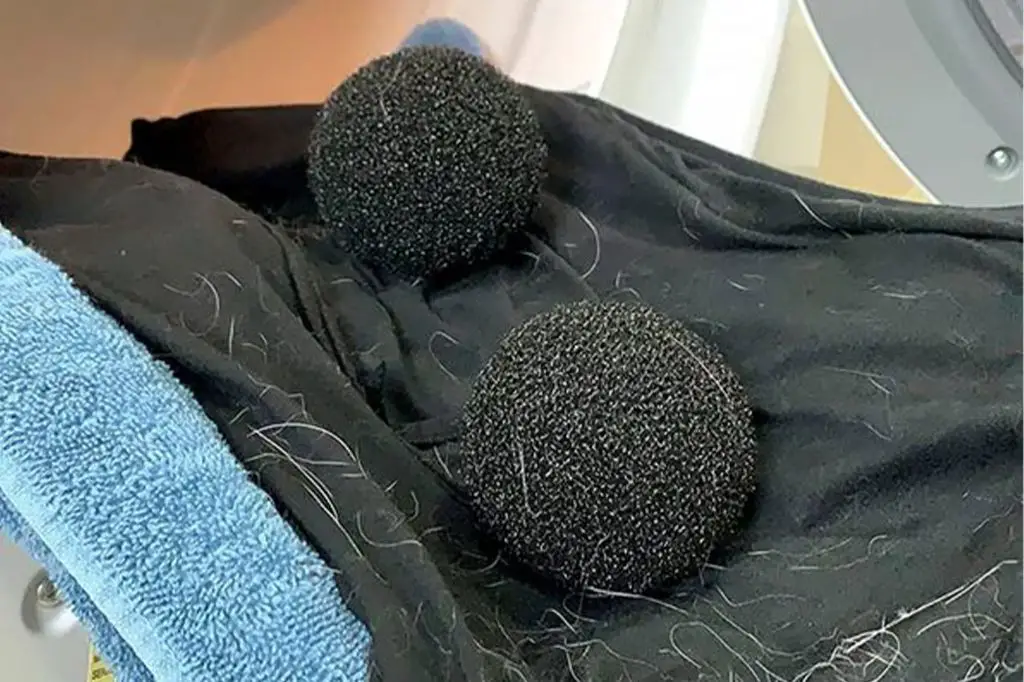Having a pet that sheds can make laundry day a hairy situation. As much as you love your furry friend, it’s frustrating when their hair ends up all over your clothes and linens. So when it’s time to dry your laundry, many pet owners wonder if using wool dryer balls can help reduce the amount of pet hair clinging to fabrics.
Page Contents
What are dryer balls?
Dryer balls are small spheres made out of wool, rubber, or plastic that are added to the dryer along with wet laundry. As the dryer drum rotates, the balls bounce around and help separate clothing items, allowing air to better circulate and reduce drying time. Wool dryer balls also help absorb moisture and reduce static cling. While traditional plastic balls don’t offer these extra benefits, some newer plastic balls contain added softening agents or fragrance beads. Compared to dryer sheets, balls are reusable and more environmentally friendly.
Do dryer balls remove pet hair from laundry?
Dryer balls are often advertised as helping to reduce lint and pet hair on laundry. However, there is debate on whether dryer balls actually help remove pet hair or simply prevent shed hair from clinging to clothes in the first place. Here’s a look at the evidence on both sides of the debate:
The case that dryer balls remove pet hair
Those who believe dryer balls help remove pet hair say that as the balls bounce around the drum, they help knock hair off clothing. The agitation from the balls helps dislodge hair that would otherwise stick to fabrics. Wool balls in particular attract lint and hair due to the nature of wool fibers. The balls’ moisture-absorbing properties may also help release pet hair that’s clung to laundry.
The case against dryer balls removing pet hair
On the other hand, some tests have shown that dryer balls don’t actually remove much pet hair already on fabrics. Rather, the main benefit is that they reduce how much hair clings to laundry in the first place. The static reduction and fabric softening of wool balls seems to be what helps prevent hair from sticking, not removing existing hair. Plastic balls likely work similarly by keeping fabrics from clinging together. Additionally, dryer lint traps catch most loose hair before it has a chance to reattach to clothing.
Do certain dryer balls work better for pet hair?
With mixed views on whether dryer balls actively remove pet hair, it’s worth looking at whether certain types are more effective choices for pet owners.
Wool dryer balls
Wool is the most popular choice for reducing pet hair issues in the laundry. The structure of wool fibers gives wool balls more surface area to attract lint and hair. Wool’s moisture wicking properties are also thought to help release hair from fabrics. And wool’s ability to soften fabrics and prevent static makes hair less likely to stick to clothing.
Plastic dryer balls
Standard plastic balls don’t offer the same hair and static reducing abilities as wool. However, some plastic balls are infused with fabric softeners, oils, or anti-static agents. These added properties allow plastic balls to mimic some of the benefits of wool, helping prevent pet hair from clinging as much.
Rubber dryer balls
Like plastic, plain rubber balls don’t have special properties to help with pet hair. But rubber infused with wool extracts or essential oils may provide similar benefits. The rigid rubber allows balls to bounce well to help keep laundry separated.
Tips for using dryer balls with pet hair
While dryer balls alone won’t completely remove all pet hair, they can still be helpful additions to laundry when you have shedding pets. Here are some tips:
- Choose wool, enhanced plastic, or infused rubber balls to get the pet hair benefits.
- Use at least 3 balls for effective motion in the dryer.
- Air dry delicate fabrics prone to pilling separately.
- Clean lint traps before and after drying loads.
- Use a lint roller on laundry right before wearing to remove any remaining hairs.
Are there better alternatives for pet hair?
If you find dryer balls don’t do enough for pet hair, here are some other options:
Lint rollers
A good old lint roller is one of the simplest ways to remove pet hair from laundry. Just roll over clothing right before wearing to quickly pick up any stray hairs. There are reusable fabric lint brushes as well.
Lint shaver
Battery-operated lint shavers use small blades to shave off pilled fuzz and pet hair from fabric surfaces. This gets hair off in a way that dryer balls can’t.
Pet hair remover brush
Special brushes have rubber nubs designed to attract pet hair and pull it off fabrics. Like lint shavers, they actively remove hair rather than just reducing cling.
Dry cleaning
For problem pet hair items, let the professionals handle it. Dry cleaners use chemical solvents that dissolve pet hair so it can be washed away.
The bottom line
Dryer balls can help reduce pet hair cling and static for easier hair removal. But they likely won’t remove much hair that’s already embedded in fabrics. For best results, use wool or enhanced dryer balls along with other hair removal methods. Focus balls on laundry that isn’t too delicate or prone to pilling. And continue using lint traps, brushes, and lint rollers to actively remove pet hair for hair-free laundry.
